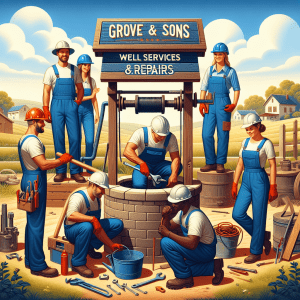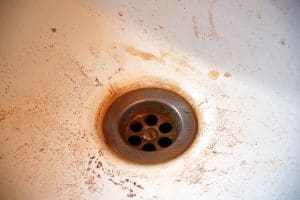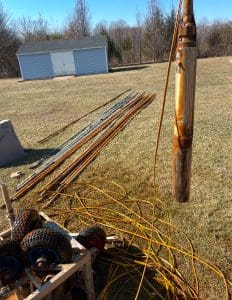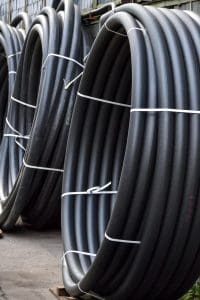
Grove & Sons Well Services & Repairs Can Help!!
This article comprehensively examines the growing galvanized pipe dangers and issues associated with aging galvanized pipes in water wells.
As galvanized piping corrodes over time, it can lead to significant concerns such as reduced water quality, compromised structural integrity, and potential health hazards.
The article delves into the technical aspects of these problems and highlights effective, budget-friendly solutions to mitigate these risks. Through detailed analysis and expert recommendations, readers gain insights into modern alternatives like black poly pipe and detailed maintenance strategies to extend the life of existing galvanized systems.
This resource serves as an invaluable guide for property owners seeking to ensure the reliability and safety of water well operations.
Key Takeaways on Galvanized Pipe Dangers
- Galvanized pipes are steel pipes coated with zinc to resist corrosion, making them durable and suitable for plumbing, construction, and industrial applications. Knowing their unique features will help you use them appropriately and effectively.
- In the hot-dip galvanization process, employees begin by degreasing steel pipes. Next, they dip the pipes in molten zinc, forming a metallurgically bonded surface layer that guarantees decades of corrosion protection. Proper coating application and preparation techniques are essential to ensure long-lasting durability.
- Schedule 40 galvanized pipes, distinguished by their uniform wall thickness, provide consistent pressure ratings and durable strength. They’re more durable and versatile than copper, making them a top choice for residential and commercial plumbing systems.
- Galvanized pipes provide corrosion resistance, durability, affordability, and versatility. Unfortunately, they can also experience issues such as internal rusting, loss of water pressure, and lead leeching in older systems.
- Frequent maintenance, corrosion checks, inspections, flushing and replacing small leaks allow galvanized pipe systems to last longer. Corrosion water treatment options can help alleviate corrosion damage while ensuring no compromised water reaches end users.
- Repairing vs. Replacing Galvanized Pipes – Avoid Galvanized Pipe Dangers. When determining whether to repair or replace your galvanized pipe, consider concerns about deterioration, water safety, and cost. Other materials like PVC, PEX, and galvanized steel can also be used for well drop pipes, but black poly pipe is a popular choice for its versatility and ease of use.
- Black poly pipe, also known as high-density polyethylene (HDPE) pipe, is commonly used in water wells, particularly for submersible

Black poly
pumps, due to its flexibility, ease of installation, and corrosion resistance. We find that Black poly is the best solution for many customers.
What is Galvanized Pipe?
Galvanized pipe is a steel pipe dipped in molten zinc to make it rustproof. This layer of zinc acts like a protective shield, protecting the steel underneath from water and other corrosive factors that typically cause corrosion. Galvanized pipes are highly durable and generally last 40 to 50 years. Their life expectancy varies widely depending on the galvanizing process employed and the silicon content of the steel itself. For example, silicon concentrations exceeding 0.25% will significantly increase the growth rate of the zinc-alloy layer and may compromise its protective effectiveness.
1. Definition of Galvanized Pipe
Galvanized pipes consist of steel pipes with a thick coating of zinc fused to the exterior. This zinc layer acts as a sacrificial coating, corroding before the underlying steel, increasing the pipe’s lifespan. This is particularly useful in the case of piping used in plumbing systems, as water exposure is near-constant. Hot-dip galvanizing and Schedule 40 are standard terms used to describe these pipes. While hot-dip galvanizing is a term for applying zinc, Schedule 40 refers to the thickness or strength of the pipe wall.
2. Galvanization Process Explained
During the hot-dip galvanization, steel pipes are cleaned to remove any remaining impurities and immersed in pure molten zinc. The second stage of the galvanizing reaction, the iron/zinc metallurgical bond, is formed during this process, precipitating into a strong protective coating. Surface preparation—most notably, removing all surface contaminants—is the key to giving hot-dip galvanizing a uniform coating and the best long-term corrosion protection. Poor application techniques can shorten the zinc layer’s lifespan to 30-40 years, highlighting the importance of quality control.
Identifying Galvanized Pipes
Galvanized steel pipes, commonly used in homes built before the 1960s, are coated with a thick layer of zinc to resist rust and corrosion. Identifying these pipes is essential, as their condition can impact the water supply piping system and determine whether replacement piping material is necessary.
Visual Characteristics of Galvanized Pipes
Galvanized pipes are easy to identify, thanks mainly to their unique look. Due to their shiny or spangled finish, they are easily mistaken as copper pipes to the untrained eye. This textured look is a typical result of the galvanization process and indicates proper galvanization. Over time, exposure to the elements can dull this shine, giving way to a matte gray finish or darker. Rust or corrosion should be visible, particularly at joints or sections with long-term exposure to moisture, indicating maintenance required or loss of protective covering. Frequent visual inspection is necessary to ensure the pipe integrity and service life.
Distinguishing from Other Pipe Materials
In contrast to copper pipes, galvanized pipes do not have a reddish-brown color or shiny appearance. PVC pipes, in comparison, are relatively lightweight, usually white or beige and completely smooth. Galvanized pipes are much heavier than their steel core and zinc coating makes them significantly thicker. The textured surface of galvanized pipes, sometimes rough to the touch, contrasts with copper’s polished look or PVC’s plastic finish. By understanding these differences, plumbers can ensure they choose the right material for plumbing projects—preventing future compatibility problems.
Check for Markings and Stamps
Galvanized steel pipes typically have manufacturer stamps showing critical information, including the pipe’s size and grade, ensuring the piping system effectively meets project requirements. This authenticity is vital to avoid concerns related to lead service lines and potential lead poisoning.
Common Applications of Galvanized Pipe
Galvanized steel pipes, known for their protective zinc coating, are widely used across multiple sectors due to their durability and resistance to corrosion. From the comfort of your home to the complexity of the assembly line, they galvanize convenient, adaptable, sustainable solutions for people and businesses.
Water Supply Lines: Avoid Galvanized Pipe Dangers.
For decades, galvanized pipes have been known as one of the most durable materials for transporting potable water within residential and commercial structures. Their corrosion resistant zinc coating prevents rust, ensuring water stays clean on its way to your tap. Due to their strength, these pipes are often used in high-pressure systems. Installation requires careful consideration of pipe sizing and compatibility with modern plumbing materials. While some deterioration from changes like mineral deposits or lessened water flow might prove inevitable, a commitment to proactive care means you can avoid many downfalls.
Fencing and Railing
Heavy-duty outdoor projects typically use galvanized pipes, thanks to their structural strength and ability to withstand the elements. They provide a very durable structure that can withstand impact and extreme weather. This combination of durability and anti-corrosion makes them ideal for security and agricultural uses. Galvanized railings provide a modern, industrial look to patios or balconies while preventing rust from the rain and seasoning of the climate. Styles such as chain-link fences or more contemporary tubular designs often use these pipes to find utility while achieving aesthetic appeal.
Structural Support
Galvanized pipes provide incredibly sturdy structural support in industrial industries’ frameworks, scaffolds, and heavy-load applications. Their power to withstand intense stress renders them a mainstay in industrial plants and high-rise frameworks. The zinc coating contributes to long life with minimal maintenance requirements, increasing the project’s overall value. However, long-term excessive zinc intake can interfere with the absorption of other critical minerals such as copper and iron, potentially leading to deficiencies. It may also weaken the immune system and reduce “good” HDL cholesterol levels.
Industrial Uses
Galvanized steel pipes are essential in industrial irrigation systems and wastewater management, where their unmatched durability against corrosion galvanizes confidence in operations. This protective piping ensures longevity and resilience in demanding environments, safeguarding infrastructure from potential damage.
Lifespan and Durability Factors
Once the standard for residential and commercial plumbing, galvanized steel pipes were prized for their initial durability and corrosion resistance. However, lead service lines and low water pressure concerns have galvanized homeowners to seek replacement piping materials.
Average Lifespan Expectancy: Avoid Galvanized Pipe Dangers.
When first installed, galvanized pipes were projected to last at least 50 to 70 years and potentially much longer. In practice, however, many did not last 25 years before it was corrosive, and the majority failed after just 40 years in service. With diligent upkeep, you can extend their lifespan to nearly 100 years. This means keeping up with regular checks and fixing minor problems quickly. Many homes constructed before the 1960s still have these pipes. However, most are over 60 years old and approaching the end of their useful life. We know that durability starts with installation. It guarantees watertight connections and avoids stress risers that could fail after years of use.
Factors Affecting Pipe Longevity: Avoid Galvanized Pipe Dangers.
Water quality has a significant impact on durability. High mineral contents, unbalanced pH levels, and high dissolved oxygen levels contribute to rampant, harmful internal corrosion. An external factor, like constant exposure to moisture or soil that has corrosive qualities, will wear down pipes. Routine upkeep—from regularly flushing, inspecting for leaks, and testing water chemistry—prevents excess wear from occurring. High-quality materials and proper installation techniques lead to dependable, long-lasting performance.
Galvanization Techniques and Durability
Hot-dip galvanization, a process in which steel is dipped in molten zinc, provides better corrosion protection than electro-galvanization. Better protection comes with a thicker zinc coating, and new galvanization methods increase durability. Pipes 1/2 to 2 inches in diameter are still commonly used for gas lines and outdoor plumbing. Because of their many advantages, their popularity is booming.
Problems with Galvanized Pipe: Avoid Galvanized Pipe Dangers.
Galvanized steel pipes, commonly found in homes built before the 1960s, are often considered reliable. However, over time, these pipes can develop problems that may damage your plumbing system significantly and compromise water quality. Understanding these issues is crucial, primarily if you still rely on galvanized plumbing in your home.
Corrosion and Rust Buildup: Avoid Galvanized Pipe Dangers.
 Rust forms when corrosion occurs inside galvanized pipes, within the protective zinc coating, as the water slowly erodes its outer layer. Over several years, this rust can build up, decreasing the water flow and affecting the quality with rusty sediment. Signs that rust may be building up are rusty-colored water and iron-tasting water. Routine monitoring is critical for identifying incipient corrosion. Installing water softeners or using anti-corrosion treatments are preventive measures, but can reduce the damage.
Rust forms when corrosion occurs inside galvanized pipes, within the protective zinc coating, as the water slowly erodes its outer layer. Over several years, this rust can build up, decreasing the water flow and affecting the quality with rusty sediment. Signs that rust may be building up are rusty-colored water and iron-tasting water. Routine monitoring is critical for identifying incipient corrosion. Installing water softeners or using anti-corrosion treatments are preventive measures, but can reduce the damage.
Reduction in Water Pressure
Rust and scale build up inside galvanized pipes over time, limiting water flow. This accumulation causes extreme decreases in water pressure, which can turn simple daily activities, such as taking a shower or cleaning dishes, into annoying experiences. It is essential to act quickly by cleaning impacted areas or potentially replacing the entire pipe to keep it working correctly.
Water Discoloration Issues
Rust particles that break loose from corroded pipes usually lead to discoloration, the most noticeable sign of water quality issues. This gives an unpleasant aesthetic and may also be a health hazard if leaching occurs, which is likely in older systems.
What is leaching? Leaching is a natural process involving removing soluble substances or contaminants from soil, rock, or waste material through water percolation. As water moves through these materials, it dissolves minerals and other compounds, transporting them to lower layers or into groundwater. This process can have significant environmental impacts, such as contaminating water supplies with harmful substances.
Leaks and Pipe Failure
When corrosion occurs, pipe walls weaken, making leaks more likely. Warning signs, like water staining or loss of pressure, almost always signal a failure is about to occur. Making timely repairs or replacing them can save thousands from a potential water damage claim.
Potential for Well Contamination: Avoid Galvanized Pipe Dangers.
Aging galvanized steel pipes can leach lead or rust into private wells, causing serious concerns about drinking water safety. Routine testing of well water and home inspection services for piping systems are essential to ensure safety in these water supply pipes.
Safety and Health Considerations
Understanding how galvanized steel pipes can affect safety and health is essential. These pipes, commonly used in vintage homes built before the 1980s, can leach lead into drinking water, leading to serious health concerns. Issues like lead poisoning and zinc exposure deserve careful attention to ensure a safe water supply and sustainable practices.
Concerns About Lead Contamination: Avoid Galvanized Pipe Dangers.
Older galvanized pipes used to transport water are a source of lead contamination, as lead can leach into drinking water when the pipes corrode. Lead exposure is associated with several severe health risks, including developmental delays in children and kidney damage in adults. It doesn’t take much to do damage in the long run. To reduce these risks, replacing those old pipes is central. Modern plumbing materials like black poly or PEX are safer and non-toxic options. Addressing lead in drinking water is crucial. Testing water for lead is critical, mainly when pipes are seen to corrode, flake, or change color. You can purchase home testing kits or contact local water authorities for professional testing options.
Zinc Leaching and Health Risks: Avoid Galvanized Pipe Dangers.
Galvanized pipes are at risk for zinc leaching, especially when they contact acidic water. Although zinc is an essential nutrient, high levels can cause nausea, stomach cramps, and long-term health problems. Regular water testing to monitor zinc levels will ensure that safety remains a top priority. Installing point-of-use or whole-home water softeners, filters, or other systems engineered to lower metal content can further mitigate risk. Routine pipe inspections help ensure that pipes don’t fail.
Environmental Impact of Galvanized Pipes: Avoid Galvanized Pipe Dangers.
When galvanized pipes are disposed of, they have an adverse environmental impact. Fortunately, while traditional plastics pose considerable recycling challenges, their recyclability provides a sustainable solution for repurposing materials. Committing to recycling facilities and choosing safer, greener alternatives can help mitigate this waste. Embedding sustainable practices into plumbing operations protects our planet’s resources from the built environment.
Maintenance and Best Practices
Maintenance best practices for actions around galvanized pipes will prevent future issues and keep them performing for years. A structured approach can avoid common problems like corrosion and blockages, keeping your plumbing system reliable and efficient. Here are some practical tips and tactics that you can implement to maintain galvanized pipes from now on.
- Schedule regular inspections to check for corrosion or wear.
- Flush pipes periodically to maintain water flow and quality.
- Tend to leaks and minor repairs quickly to prevent them from becoming expensive emergency work.
- Use water treatment solutions to minimize corrosion risks.
Regular Inspection Tips: Avoid Galvanized Pipe Dangers.
Routine inspections are critical for spotting the first signs of wear in galvanized pipes. Pay special attention to places where corrosion could occur, like joints and fittings, where moisture can build up. Age-related signs include rust, discoloration, and reduced water pressure. A checklist can streamline inspecting visible pipes, testing water quality, and ensuring secure fittings. What’s better than waiting until significant damage has already occurred? Early detection saves time and money.
Preventing Corrosion: Avoid Galvanized Pipe Dangers.
As the American Water Works Association explains, corrosion begins with the chemistry of the water. Hard water speeds up corrosion due to its high concentration of minerals. Installing a water softener or increasing the pH can help prevent this process from speeding up. To avoid damage from the elements, insulate outdoor pipe sections along the way and keep pipes from direct contact with soil or concrete.
Water Treatment Options
Water treatment makes pipes last longer. Filtration systems take out debris that can scratch delicate pipe linings.
- Chemical treatments, such as pH balancers, neutralize the acidic water. Ongoing water testing monitors baseline quality and any deviations, and corrosion inhibitors form a protective coating inside pipes.
Addressing Minor Issues Promptly
As with any other machinery, minor issues—a tiny leak or a loose fitting—can become catastrophic if neglected.
- Leak detection through regular inspections with rapid repair responses avoids needless water loss and building deterioration.
- Be proactive—tighten loose connections and replace old washers to prevent recurring problems. Proactive, preventive care saves money in the long term while maintaining the integrity and efficiency of the system.
Repairing or Replacing Galvanized Pipe: Avoid Galvanized Pipe Dangers.
Determining the best option between repairing or replacing galvanized pipes will be impossible without a comprehensive grasp of their current state and expected longevity. These types of pipes are prevalent in homes built before the 1960s. Most of them have been in service for over 40 years and counting, with some systems lasting as long as 70 years! Although repairs can address individual issues, they typically only offer a short-term solution. Considering their age and propensity to corrode, replacing galvanized pipes is generally the more sustainable.
When to Repair vs. Replace: Avoid Galvanized Pipe Dangers.
Repairs make sense for small leaks, clogs, or other localized, limited pipe damage. In the case of piping, such as a single relocated joint, splice, or section, restoring service can be significantly less disruptive. Widespread corrosion, reduced water pressure, or discolored water often indicate systemic issues requiring replacement. That’s why the contribution of consulting professionals, like Grove & Son Well Service & Repair, is critical—they use technology, including video inspections, to determine what’s going on inside the pipe. You’re equipped to make better long-term choices with detailed analysis, balancing immediate expenses with future liabilities.
Replacement Material Options
Modern repair and replacement materials provide better value, longevity, and performance than galvanized steel. Black poly, which is highly flexible and doesn’t corrode like metals, is another option that’s taken our business by storm. Copper offers unparalleled peace of mind and has been durable for years. PVC, which is durable, lightweight, and economical, is ideal for any non-potable application. Though higher in cost, stainless steel meets the need for high-strength applications. Every material has pros and cons regarding price, lifespan, and suitability, so having an expert weigh-in helps guarantee the ideal match for your home.
The Galvanized Piping Removal Process

Old galvanized pipe and well pump in White Plains, MD
Removing galvanized pipes requires turning off the water, draining the lines, and removing them in sections, taking care to avoid damage. Proper disposal ensures materials stay out of the environment, while personal protective equipment such as gloves and safety goggles keeps workers safe. Taking steps to prepare the area by clearing all obstructions and ensuring a clear pathway increases efficiency.
Conclusion: Avoid Galvanized Pipe Dangers.
Used for decades in plumbing and construction, galvanized pipes have become an essential material. Their durability and protective zinc coating helps them resist corrosion. They’ve proven successful in various applications throughout the years, but have exposed challenges such as mineral buildup and possible leaks. Knowing how long they last, how to take care of them, and when you should replace them will save you from more significant problems in the future. Consider greener options such as Black poly to avoid galvanized pipe dangers. Keep abreast of building codes to ensure you make the best choice for your applications and requirements. We can help you with that. Whether you’re maintaining, repairing, or upgrading, you’re always focused on providing the safest, most efficient water flow, and long-lasting, dependable performance. Whether you’re waiting to purchase a new system or designing your next project, don’t delay! That’s why now is the right moment to use data to drive smart investments.
Frequently Asked Questions on How to Avoid Galvanized Pipe Dangers.
What is galvanized pipe made of?
Galvanized steel pipes consist of steel dipped in a hot zinc solution, creating a protective coating that prevents corrosion. This galvanized plumbing is essential for extending the functional life span of water supply pipes in outdoor applications.
How can I identify galvanized pipes in my home? Galvanized Pipe Dangers.
Check for galvanized steel pipes with rusty gray or metallic appearances. If you scratch the surface, you might discover a shiny silver layer beneath, indicating a protective zinc coating.
What are the common uses of galvanized pipe?
Galvanized steel pipes are commonly used for indoor plumbing and outdoor applications like railings and irrigation systems. They provide a durable solution that can help galvanize structural support in long-span projects.
How long do galvanized pipes typically last? Avoid galvanized pipe dangers.
Galvanized steel pipes are designed to last 40–50 years, but water quality and environmental factors can affect their lifespan.
Are galvanized pipes safe for drinking water?
Over time, galvanized steel pipes can release trace amounts of lead, causing concern due to potential lead poisoning. Rehabilitation or replacing older piping systems is considered the best approach to ensuring safe drinking water.
What maintenance is needed for galvanized pipes?
Inspect galvanized steel pipes at least once a year for rust, cracks, or leaks, and check for discolored or fluctuating water flow. Regularly flush your plumbing system to prevent premature corrosion and ensure a functional life span.
Should I replace galvanized pipes with an alternative? Galvanized Pipe Dangers.
Yes, replacing old galvanized steel pipes with Black poly is usually the best option for many reasons. These options are long-lasting, fire-resistant, meet today’s building standards, helps avoid galvanized pipe dangers and prevents issues like low water pressure.
References: Avoid Galvanized Pipe Dangers.
Is Your Galvanized Pipe for Water a Ticking Time Bomb? Risks & Replacements Explained




0 Comments